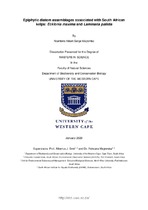| dc.contributor.advisor | Smit, Albertus J. | |
| dc.contributor.advisor | Majewska, Roksana | |
| dc.contributor.author | Mayombo, Ntambwe Albert Serge | |
| dc.date.accessioned | 2020-12-09T12:11:19Z | |
| dc.date.available | 2021-01-01T22:10:05Z | |
| dc.date.issued | 2020 | |
| dc.identifier.uri | http://hdl.handle.net/11394/7717 | |
| dc.description | Magister Scientiae (Biodiversity and Conservation Biology) | en_US |
| dc.description.abstract | Kelp forests are dynamic and productive ecosystems which host large biodiversity of sessile
fauna and flora, including diatoms. These microalgae occur at the base of coastal marine
food webs and contribute substantially to the productivity of marine ecosystems. Diatoms
constitute one of the most common and species-rich groups of both phytoplankton and
phytobenthos. Possessing a unique silica cell wall, diatoms play a key role in the global
carbon and silicon cycles. As the changes in species composition of diatom communities are
a direct reaction to the combination of environmental factors prevailing in their ecosystems,
diatom analysis is widely and successfully used in biomonitoring of various environmental
conditions and paleoecological reconstructions. | en_US |
| dc.language.iso | en | en_US |
| dc.publisher | University of Western Cape | en_US |
| dc.subject | Epiphytic diatoms | en_US |
| dc.subject | Bacillariophyceae | en_US |
| dc.subject | Diatom abundances | en_US |
| dc.subject | Cocconeis | en_US |
| dc.subject | Gomphoseptatum | en_US |
| dc.title | Epiphytic diatom assemblages associated with South African kelps: Ecklonia maxima and Laminaria pallida | en_US |
| dc.rights.holder | University of Western Cape | en_US |

